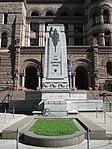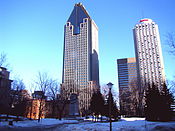Cenotaph


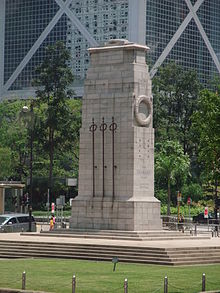
A cenotaph is an empty tomb or a monument erected in honour of a person or group of people whose remains are elsewhere. It can also be the initial tomb for a person who has since been reinterred elsewhere. Although the vast majority of cenotaphs honour individuals, many noted cenotaphs are instead dedicated to the memories of groups of individuals, such as the lost soldiers of a country or of an empire.
History and etymology[]
The English word "cenotaph" derives from the Greek: κενοτάφιον kenotaphion (κενός kenos, meaning "empty", and τάφος taphos, "tomb").[1][2][3]
Cenotaphs were common in the ancient world. Many were built in Ancient Egypt, Ancient Greece and across Northern Europe (in the shape of Neolithic barrows).
The cenotaph in Whitehall, London — designed in 1919 by Sir Edwin Lutyens — influenced the design of many other war memorials in Britain and in the British sectors of the Western Front, as well as those in other Commonwealth nations. Lutyens' cenotaph was chosen as a deliberately secular monument.[4]
The Church of Santa Engrácia, in Lisbon, Portugal, turned into a National Pantheon in 1966, holds six cenotaphs, namely to Luís de Camões, Pedro Álvares Cabral, Afonso de Albuquerque, Nuno Álvares Pereira, Vasco da Gama and Henry the Navigator.
The Basilica di Santa Croce in Florence, Italy, contains a number of cenotaphs, including one for Dante Alighieri, who is buried in Ravenna.
Regional[]
Africa[]
South Africa[]
Durban, South Africa, has a striking and unusual cenotaph made of granite and lavishly decorated with brightly coloured ceramics.
Port Elizabeth, South Africa, has a cenotaph. Located on the edge of St George's Park in Rink Street, it was designed by Elizabeth Gardner to commemorate the men who died in the First World War (1914–1918) and was erected by the monumental mason firm of Pennachini Bros. On either side of the central sarcophagus are statues by Technical College Art School principal, James Gardner, who served in the trenches during the war. One depicts St George and the Dragon, the other depicts the sanctity of family life. Surrounding the sarcophagus are a number of bas-relief panels depicting scenes and people during the First World War. It was unveiled by Mrs W F Savage and dedicated by Canon Mayo on 10 November 1929. A surrounding memorial wall commemorates the men and women killed during World War II.
Zambia[]
In Livingstone there is a cenotaph at the Eastern Cataract of The Victoria Falls with the names of the men of Northern Rhodesia who died during the Great War 1914–18. It was unveiled by Prince Arthur of Connaught on 1 August 1923.
There is also a cenotaph in Lusaka at Embassy Park, opposite the Cabinet Office along Independence Avenue, and commemorates those Zambians who fought and died in World Wars I & II. The cenotaph was commemorated in 1977.[5]
The Americas[]
Argentina[]

A monument which has come to be known to as the "Cenotaph" was erected in Plaza San Martín, in downtown Buenos Aires, to commemorate the Argentinian soldiers who died during the Falklands War, in 1982. The monument consists of a series of plaques of black marble with the names of the fallen, surrounding a flame, and during the day is guarded by two soldiers.
Another cenotaph, which is a replica of the Argentine Military Cemetery in Darwin on the Falkland Islands, exists in Campo de Mayo, a large Army facility and training field just outside Buenos Aires.
Bermuda[]
A limestone replica of the Cenotaph at Whitehall in London was erected outside the Cabinet Building in Hamilton, Bermuda (with the cornerstone laid in 1920, and the completed monument unveiled in 1925).[6]
Canada[]
In Canada, major cenotaphs commemorating the nation's war dead in World War I and later conflicts include the National War Memorial (a cenotaph surmounted by a bronze sculpture entitled "The Response") in Ottawa; Montreal, Toronto, Hamilton, Victoria, St. John's, Halifax, and the Victory Square Cenotaph, in Vancouver, British Columbia. and in Midland Ontario.
Falkland Islands[]

In the Falkland Islands, there are several war memorials to commemorate those killed in the Falklands War in 1982. The main memorial for Falkland Islanders is the 1982 Liberation Memorial, a cenotaph erected in Stanley in 1984 which lists all the British Army regiments, RAF squadrons, Royal Navy vessels and the Royal Marine formations and units that took part in the conflict. The names of the 255 British military personnel who died during the war are listed on ten plaques behind the Memorial, divided into the service branches.
Services are held at the Memorial each year on 14 June (Liberation Day)[7] and on Remembrance Sunday, with wreaths being laid at the foot of the Memorial.[8]
United States[]
In the United States, a cenotaph in Yale University's Hewitt Quad (or Beinecke Plaza) honours men of Yale who died in battle. The John Fitzgerald Kennedy Memorial in Dallas is often described as a cenotaph.
The Battle Monument in Baltimore, Maryland commemorates the Battle of Baltimore, the Battle of North Point on 12 September 1814, the Bombardment of Fort McHenry on 13–14 September, and the stand-off on Loudenschlager's Hill (now Hampstead Hill in Patterson Park). It has an Egyptian Revival cenotaph base, surmounted by a fasces bound together with ribbons bearing the names of the dead. It was designed by French émigré architect Maximilian Godefroy in 1815, and construction was completed in 1827. It is considered[who?] the first war memorial in America, and an early example of a memorial to individual soldiers. The Monument appears on the Seal and the Logo of the City of Baltimore, and serves as a symbol for any agencies of the municipal government.[9]
A cenotaph for the defenders of the Battle of the Alamo (March 1836) stands in front of the Alamo mission chapel in San Antonio, Texas. The cenotaph is empty because the remains of the fallen were cremated.
Atop War Memorial Chapel at Virginia Tech, there is a cenotaph honouring all Virginia Tech cadets who have been killed in battle. Inscribed upon the cenotaph are the names of the seven Virginia Tech alumni who have been awarded the Medal of Honor.
The United States Capitol was constructed with the intention that it house the tomb of George Washington and contains a crypt and burial chamber directly below its rotunda. Due to a disagreement between his family, the Commonwealth of Virginia, and the federal government, his body was never moved there, making it a de facto cenotaph.
Asia[]
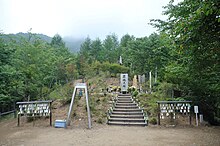
In Asia, the Cenotaph in Central District of Hong Kong Island, cenotaphs in Kuala Lumpur, George Town, Ipoh, Seremban and Jesselton in Malaysia, the Cenotaph in Singapore, the Cenotaph in Colombo and the stone Cenotaph in the new Allenby Square, Romema, Jerusalem – were erected as memorials to the war dead of World War I.
Various cenotaphs in Asia have also been erected to commemorate the dead from events outside conventional Western coverage. The concrete Memorial Cenotaph at the Hiroshima Peace Memorial Park was designed by Kenzo Tange to commemorate the victims of the August 1945 atomic bomb attacks. The cenotaph at the 228 Peace Memorial Park in Taipei, Taiwan was erected as a memorial to the February 28 incident. In the Philippines, a cenotaph was erected inside the Manila North Cemetery in honour of the 24 Scouts who died in a plane crash en route to the 11th World Scout Jamboree.
Europe[]
France[]

In the Museum of Aquitaine, in Bordeaux, there is the famous cenotaph of Michel de Montaigne, a French Renaissance writer and philosopher. The tomb was sculpted in 1593, a year after his death on the request of his wife, Françoise de la Chassaigne, probably by Prieur and Guillerman, two Bordeaux ornamentists.[10]
On the cenotaph, next to the coat of arm, there are two epitaphs, in Greek and in Latin. The one in Latin begins by : "To Michel de Montaigne, son of Pierre, grand-son of Grimond, grand-grand-son of Raymond, knight of Saint-Michel, ex-mayor of the city of Bordeaux, a man born for the glory, with gentle manners, a witty mind..."[11]
United Kingdom[]
London[]
A cenotaph in the UK that stands in Whitehall, London, was designed by Sir Edwin Lutyens[12] and replaced Lutyens' identical wood-and-plaster cenotaph erected in 1919 for the Allied Victory Parade, and is a Grade I listed building.[13] It is undecorated save for a carved wreath on each end and the words "The Glorious Dead," chosen by Lloyd George. It was intended to commemorate specifically the victims of the First World War, but is used to commemorate all of the dead in all wars in which British servicemen and women have fought. The dates of the First World War and the Second World War are inscribed on it in Roman numerals. The design was used in the construction of many other war memorials throughout the British Empire.
Belfast[]
The Cenotaph in Belfast, Northern Ireland, is located in the grounds of Belfast City Hall and is set within a Garden of Remembrance. It is about 9.5 metres (31 ft) high and presents several carvings including laurel wreaths, symbolising victory and honour. The Cenotaph is the site of the annual Northern Ireland memorial held on Remembrance Sunday, the closest Sunday to 11 November (Armistice Day).
The Middle East[]
Jerusalem[]
Ottoman-ruled Jerusalem surrendered to the British Egyptian Expeditionary Force under General Edmund Allenby during the Battle of Jerusalem in December 1917 during World War I. A cenotaph was erected in 1920 at the historical site of the surrender, later to be named Allenby Square. The inscription dedicates it to the fallen of the 60th London Division.
Oceania[]
Australia[]
In Australia, Anzac Day commemorations are usually held at all of the nation's many war memorials, but not all of them are cenotaphs. Cenotaphs include the Hobart Cenotaph and the Sydney Cenotaph.
New Zealand[]
Anzac Day commemorations are usually held at local war memorials as in Australia. Cenotaphs include the Dunedin Cenotaph, the Wellington Cenotaph and the Auckland War Memorial Museum Cenotaph (a copy of the Whitehall Cenotaph).
Cenotaphs for the missing[]
Although most notable cenotaphs commemorate notable individuals buried elsewhere, many cenotaphs pay tribute to people whose remains have never been located, particularly those lost at sea. Some such cenotaphs are dedicated to victims of the RMS Titanic whose bodies were not recovered after the sinking. Although Isidor Straus's body was recovered, Ida Straus's body was not, and a cenotaph at the Straus Mausoleum at Woodlawn Cemetery in the Bronx is dedicated to Isidor and Ida together. Its inscription reads: "Many waters cannot quench love – neither can the floods drown it."[14] (Song of Solomon 8:7) The striking cenotaph of Major Archibald Butt, aide to U.S. President William Taft, is located at Arlington National Cemetery.[15]
In Inishmore, one of the Aran Islands of Ireland, drowning was formerly such a common cause of death for island fishermen that each family had a memorial to those lost at sea known as leachtaí cuimhneacháin (memorial cairns). Most were erected in the 19th century, although some date back to the eighteenth. A modern memorial was erected in 1997.[16][17]
Chhatris[]
This section does not cite any sources. (June 2019) |

In India, cenotaphs are a basic element of Hindu architecture, later used by Moghuls as seen in most of the mausoleums of Mughal Emperors which have two burial chambers, the upper one with a cenotaph, as in Humayun's Tomb, Delhi, or the Taj Mahal, Agra, while the real tomb often lies exactly below it, or further removed. The term chhatri, used for these canopylike structures, comes from Hindustani word literally meaning umbrella, and are found throughout the northwestern region of Rajasthan as well as in Madhya Pradesh and Maharashtra. In the Shekhawati region of Rajasthan, chhatris are built on the cremation sites of wealthy or distinguished individuals. Chhatris in Shekhawati may consist of a simple structure of one dome raised by four pillars to a building containing many domes and a basement with several rooms. In some places, the interior of the chhatri is painted in the same manner as the Haveli.
Art[]
Cenotaphs have also been the subject of a number of illustrations including:
- The Cenotaph to Reynold's Memory (John Constable, c. 1833)
- Elevation for Newton's Cenotaph, Perspective (Etienne-Louis Boullée, c. 1785)
- The Cenotaph of Jean Jacques Rousseau (Hubert Robert, 1794)
Poetry[]
Cenotaph is used in [18] (1833) poem, Scientific Theories:
O Science! proud Iconoclast, thy way
Is strewed with fragments of our reverence
And love—idols with small or no pretence,
Right oft, upon their pedestals to stay,
The light oft intercepting of God's day,
E'en in His Temple! Light too pure, intense,
Which puts the eye out, dazzles the weak sense
Of mere Humanity, after its clay
Shaping its images. But take thou good heed
Thou dost not, in self-blindness and self-pride,
Pluck down the Temple's self, and, in its stead
And on its ruins, strewed far and wide,
Building as not for Living but True-dead,
A cenotaph for Man's lost Soul provide!
Mentioned in Mrs Dalloway by Virginia Woolf
Digital and astronomical[]
In the Internet age, virtual cenotaphs are common in the game World of Warcraft.[19][20] and in The Elder Scrolls Series games though modding add ons. [21][22][23][24]
They have also been created in the augmented reality game Ingress in honour of the slain MIT police officer Sean Collier[25] and in memory of the victims of the 1942 Struma disaster.[26]
On 13 January 2016, Belgian amateur astronomers at MIRA Public Observatory dedicated, in conjunction with radio station Studio Brussels, an asterism of seven stars in the vicinity of Mars which had been photographed at the exact time of David Bowie's death; when appropriately connected they form the iconic lightning bolt of Aladdin Sane.[27][28]
Gallery[]
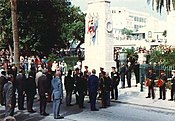
Remembrance Day parade, at the Cenotaph in the City of Hamilton in the British Overseas Territory of Bermuda

Cenotaph, Grand Parade (Halifax), Nova Scotia, Canada
Cenotaph, Port of Spain, Trinidad and Tobago
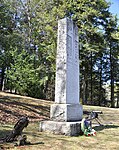
Cenotaph, Flesherton, Ontario, Canada
Port Arthur Cenotaph, Waverley Park, Thunder Bay, Ontario
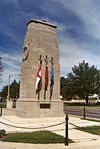
Cenotaph, Victoria Park, London, Ontario

Great War Memorial, Niagara Falls, Ontario

Cenotaph (Victoria), Victory Square, Vancouver, British Columbia
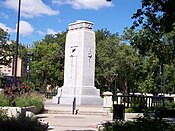
Cenotaph, Victoria Park, Regina, Saskatchewan

The Cenotaph located in Donegall Square in Belfast
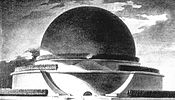
Étienne-Louis Boullée, fantasy sketch Cénotaphe a Newton (1784)
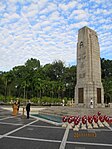
Kuala Lumpur cenotaph, National Monument, Kuala Lumpur, Malaysia

The Cenotaph located in 228 Peace Memorial Park in Taipei, Taiwan
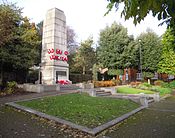
Cenotaph in Aldershot in the UK, 'Home of the British Army'

National Monument, Amsterdam, The Netherlands
See also[]
- Cross of Sacrifice
- Epitaph
- Grave
- Memorialization
- Munstead Wood
- Shrine of Remembrance in Melbourne, Victoria, Australia
- Stone of Remembrance
- Tomb of the Unknown Soldier
- Tropaeum Traiani
- War memorial
- Donkin Heritage Trail
References[]
- ^ Whitney, William Dwight (1914), The Century Dictionary: The Century dictionary, Century Company, p. 882
- ^ κενοτάφιον, κενός, τάφος. Liddell, Henry George; Scott, Robert; A Greek–English Lexicon at the Perseus Project.
- ^ Harper, Douglas. "cenotaph". Online Etymology Dictionary.
- ^ Snow, Dan. "Remembrance Sunday should not be dominated by religion". Guardian.
- ^ The Zambian Freedom Trail Project, pamphlet phase 1 published with support by U.S. Embassy, Lusaka, Zambia
- ^ "Bermuda Cenotaph". Retrieved 16 October 2015.
- ^ "Commemorations for 35th anniversary of Liberation Day held in Falklands". MercoPress. Retrieved 14 February 2018.
- ^ "Falklands Observance of Remembrance Day on Sunday 12 November". MercoPress. Retrieved 14 February 2018.
- ^ Dorsey, John & Dilts, James D., Guide to Baltimore Architecture (1997) p. 145–146. Tidewater Publishers, Centreville, Maryland ISBN 0-87033-477-8
- ^ http://www.musee-aquitaine-bordeaux.fr/en/article/montaignes-tomb
- ^ https://en.anecdotrip.com/anecdote/montaignes-cenotaph-in-bordeaux-aquitaine-museum-by-vinaigrette
- ^ Skelton & Gliddon – Lutyens and the Great War, published 2008, Pages 23–47 (also see external link below: Cenotaph of Sigismunda and Lutyen's Whitehall Cenotaph)
- ^ "Buildings of outstanding or national architectural or historic interest."
- ^ "Many Waters Cannot Quench Love" http://www.straushistoricalsociety.org/documents.html
- ^ "Titanic Memorials: Archibald Butt Cenotaph, Arlington National Cemetery – Arlington, VA". Retrieved 11 July 2010.
- ^ "Leachtaí Cuimhneacháin (Stone Memorials for Dead)". Aran Islands. Retrieved 16 October 2015.
- ^ Mike. "Have you been to Inis Mhór – the largest of the Aran Islands off County Galway? – Your Irish Heritage". Your Irish Heritage. Retrieved 16 October 2015.
- ^ Ellison, Henry. "Scientific Theories". sonnets.org. Retrieved 18 May 2017.
- ^ "Game Studies". Retrieved 16 October 2015.
- ^ A Tribute to World of Warcraft Memorials. YouTube. 13 January 2013. Retrieved 16 October 2015.
- ^ "In Memory of Hugh". Retrieved 16 March 2019.
- ^ "RIP Hugh Walker, 1949 – 2016". Retrieved 16 March 2019.
- ^ "Bear – In memory of Taylor". Retrieved 16 March 2019.
- ^ "The top post on r/gaming right now is about a Skyrim fan's "memorial". Maybe deserving of a mod?". Retrieved 16 March 2019.
- ^ Scott Kirsner (24 April 2013). "In Google's Ingress augmented reality game, a ceasefire at MIT and a memorial to slain officer Sean Collier". Boston Globe. Retrieved 2 June 2013.
- ^ "Operation Struma". Retrieved 16 October 2015.
- ^ "StardustForBowie, Mira in the eye of a Cyclone..." Archived 23 January 2016 at the Wayback Machine. MIRA. Retrieved 19 January 2016
- ^ Kreps, Daniel (16 January 2016). "Belgian Astronomers Pay Tribute to David Bowie With New Constellation". Rolling Stone.
Further reading[]
- The Secret of the Cenotaph by Andrew Crompton, 1999
- Stilling the Pulse of Time by Bruce Cole, Wall Street Journal, 8 November 2013
External links[]
| Look up cenotaph in Wiktionary, the free dictionary. |
 Media related to Cenotaphs at Wikimedia Commons
Media related to Cenotaphs at Wikimedia Commons- . Encyclopædia Britannica. 5 (11th ed.). 1911.
- The New London School explosion cenotaph Memorial Archived 8 March 2016 at the Wayback Machine
- Cenotaph of Sigismunda and Lutyen's Whitehall Cenotaph
- Royal British Legion article
- World War I memorials
- Cenotaphs
- Acknowledgements of death








